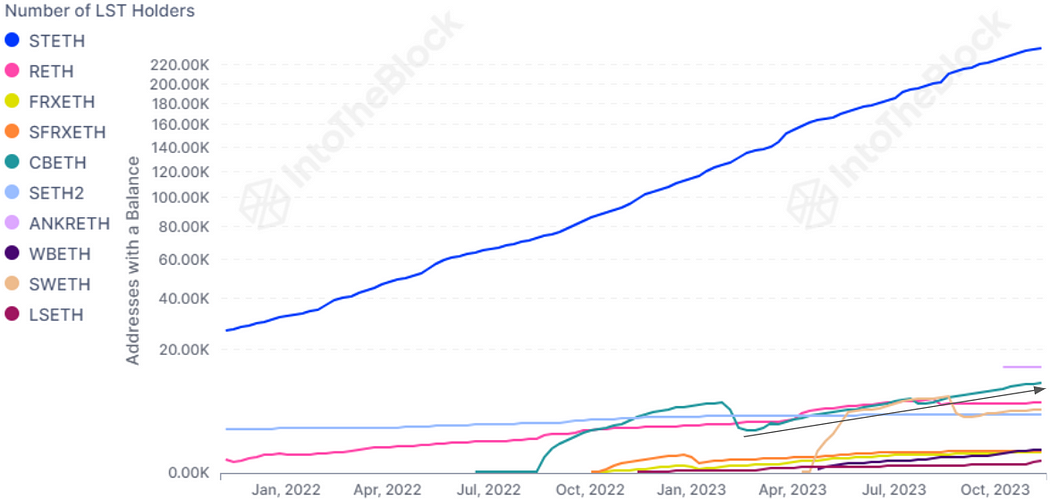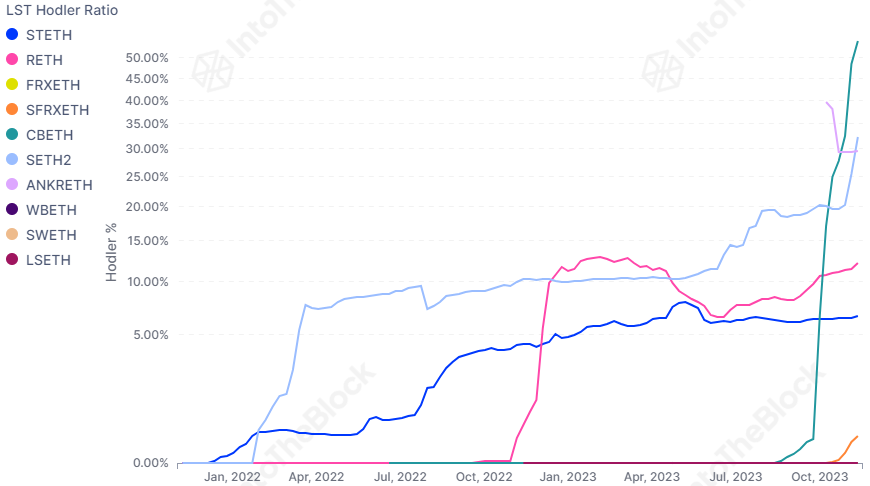Overview of the Ethereum ecosystem's liquid staking landscape: Lido's level of centralization decreases, and protocol diversity increases
Author: Pedro M. Negron, Junior Research Analyst at IntoTheBlock
Compiled by: Felix, PANews
Liquid Staking Tokens (LST) allow users to earn yields from PoS blockchains without locking their assets. This concept has evolved into one of the most important sub-sectors in the crypto space. As of November 2023, approximately $20 billion is staked through Ethereum LSTs. Given the massive scale of the staking market, many participants have ventured into the liquid staking of the Ethereum ecosystem, with Lido's stETH remaining the leading LST. However, other protocols have also made significant progress, especially after the Shapella upgrade in April 2023, which allowed users to withdraw staked tokens.
As liquid staking protocols enter the market, many introduce unique operational mechanisms to gain a competitive edge. Lido has played a dominant role in the liquid staking space within the Ethereum ecosystem, relying on institutional node operators to capture a large market share, holding over 90% of the Ethereum liquid staking market before the Shapella upgrade. With the launch of the Shapella fork and increasing investor confidence in holding LSTs, the market share of new protocols has increased, currently accounting for about 15%.

Source: IntoTheBlock
New liquid staking protocols are attempting to stand out in various ways. For example, Rocket Pool, whose rETH token holds the second-largest market share, is characterized by its commitment to decentralization. The main goal of the protocol is to foster a decentralized validator community, ensuring that the power of validators is not concentrated in the hands of a few individuals or entities.
In addition to decentralization, other novel approaches include innovations in token models, such as the dual-token model represented by the Frax protocol. The Frax protocol's tokens are divided into frxETH and sfrxETH. In this model, one token receives significant incentives within the DeFi ecosystem, while holding the other token allows for combined staking rewards from both tokens. Specifically, frxETH maintains a 1:1 peg with ETH, while sfrxETH is a vault designed to accumulate staking rewards for Frax ETH validators. The exchange rate of sfrxETH to frxETH will increase over time as more rewards are added to the vault. (Related reading: How far is Frax Finance from "breaking into the top five by market cap" after entering popular tracks like RWA, LSD, and Layer 2?)
While Lido and its stETH token dominate the current market, various other tokens show indicators of robustness and long-term potential in the market.

Source: IntoTheBlock
Currently, the amount staked through Lido's stETH has reached $18.3 billion, and the protocol has the highest number of holders in the market, with 238,600 unique addresses. Following stETH, the number of unique addresses for ankrETH is 14,900, indicating a significant difference in the number of token holders between the two.
In addition to stETH, another noteworthy trend is the increasing number of cbETH holders, which is the Ethereum staking token launched by Coinbase a year ago. Since its launch, the number of holders of this token has continued to grow, indicating a rising demand for cbETH. Although the number of cbETH holders may not be the highest, it has surpassed other competitors, currently boasting 10,800 unique holders.
Moreover, with the expansion of cbETH, another positive sign is that cbETH has the highest proportion of Hodler users among all LSTs.

Source: IntoTheBlock
Among the addresses holding cbETH, 54.26% have held the token for over a year, demonstrating the commitment of its holders. A large number of Hodler addresses is a positive indicator, as it suggests user trust in the token and the underlying protocol.
This outcome may be attributed to Coinbase's method of cold storage for tokens. Specifically, if tokens are held in a centralized exchange in the form of customer accounts, this may indicate a lack of liquidity for the tokens. Even if this is the case, overall, it remains a positive sign. Because if demand for the token decreases, exchanges will continuously rearrange, as the tokens may be sold or destroyed.
Finally, the concentration of governance token major holders is an important metric for measuring the degree of decentralization. This metric helps identify potential adverse effects on the ecosystem due to excessive concentration among holders.

Source: IntoTheBlock
As shown in the above chart, most governance tokens in the LST ecosystem are concentrated among large holders. However, it is noteworthy that the process of decentralization is evident in Lido's development. Over the past year, the concentration of whales in the LDO token has decreased by more than 10%, from 67.8% to 56.4%.
This trend can also serve as an indicator of token maturity; lower concentration means a broader distribution among token holders, indicating a higher degree of decentralization and reduced influence of individual holders. It is common for newly launched tokens to exhibit high concentration among large holders. Therefore, considering the adoption rate and scale of Lido's stETH token, it is logical that the concentration of major holders of its governance token has decreased over time.
In conclusion, the liquid staking market within the Ethereum ecosystem presents a dynamically evolving landscape, with each token having its unique functions and user bases. While Lido's stETH token has maintained a dominant position, recent trends indicate an increasing diversity of protocols and a continuously changing competitive landscape. Notably, tokens like cbETH have gained favor among a large number of holders, highlighting their appeal and long-term potential. The proportion of Hodler users and the concentration of large holders are key indicators of the health of the token and the degree of decentralization of the ecosystem. Additionally, the decline in whale concentration among governance tokens (such as Lido's LDO) reflects the ongoing maturation of these tokens and progress toward greater decentralization.









